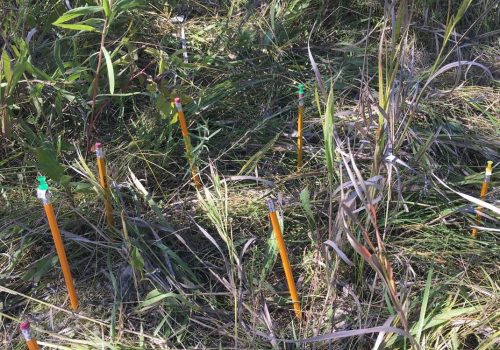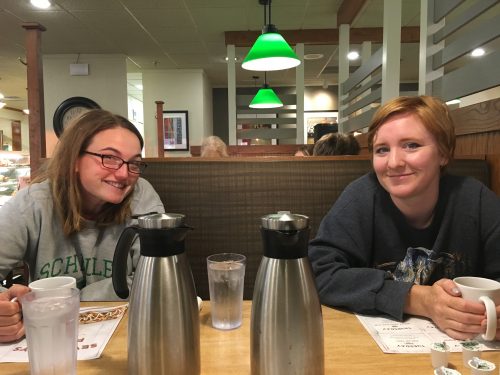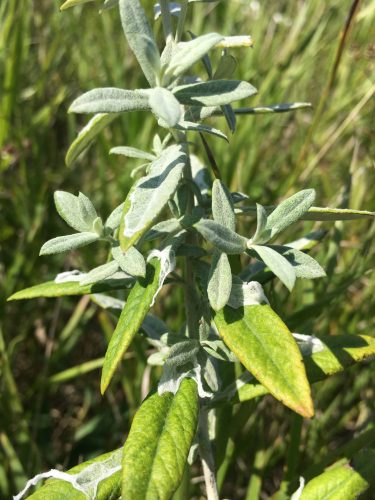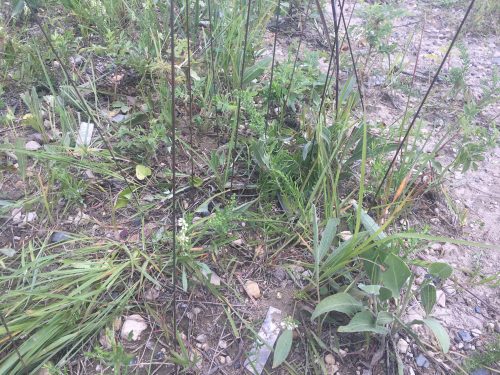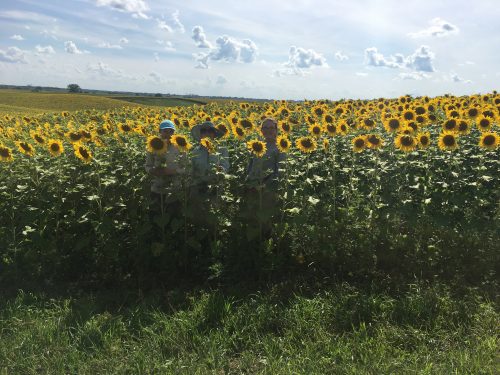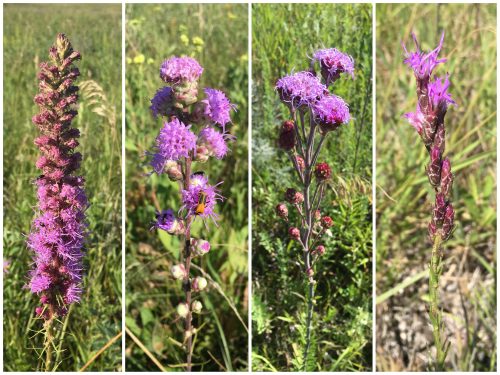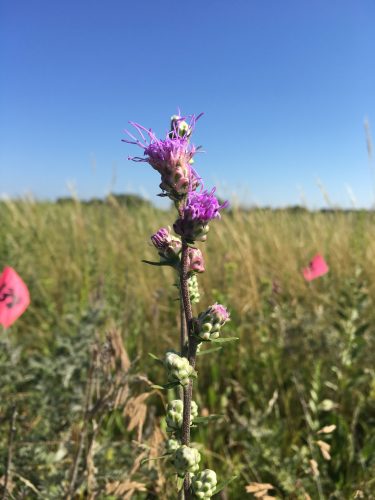|
|
 Aphids on an Echinacea leaf This summer Team Echinacea continued adding and excluding aphids to plants in the experiment that Katherine Muller started. In 2011, Katherine Muller designated a sample of 100 Echinacea plants in experimental plot 1 for aphid addition or removal. The presence or absence of these aphids was maintained by team members once a week in the summer of 2017, for a total of 7 weeks from early July to mid August. We maintained addition on 31 plants and exclusion on 30, for a total of 61 plants. Will Reed set up a data entry system where we could enter data twice from the paper sheets and check for data-entry errors. In early October, Lea Richardson and Tracie Hayes recorded signs of senescence in the leaves of treatment plants. This data can be combined with data from our common garden measuring data to explore the richness of the Echinacea-aphid relationship.
Aphis echinaceae is a specialist aphid that is found only on Echinacea angustifolia. Read more about this experiment.
Start year: 2011
Location: Experimental Plot 1
Overlaps with: Phenology and fitness in P1
Data collected:
- Aphid counts for each treatment plant on each observation day, on paper
- Aphid counts recorded in csvs, on the teamEchinacea2017 dropbox
- Leaf senescence data, recorded on paper
- Initial and final assessment of aphid counts on treatment plants, recorded on paper
- Aphid counts also included in p1 measuring data
Products:
- 2016 paper by Katherine Muller and Stuart on aphids and foliar herbivory damage on Echinacea
- 2015 paper by Ruth Shaw and Stuart on fitness and demographic consequences of aphid loads
- 2015 poster by Daniel Brown and Kyle Silverhus (Lake Forest College) on achene and seed set differences on treatment plants
You can read more about the aphid addition and exclusion experiment, as well as links to prior flog entries mentioning the experiment, on the background page for this experiment.
Art is spending the morning today counting achenes at the computer. One great thing about counting achenes is you can still tell stories while you’re doing it, and Art has quite a lot of funny and interesting stories about his earlier days volunteering at the garden.
 Art counting Echinacea achenes in the lab
Today Char and Susie have been cleaning Echinacea heads from 2016. Char is interested in Art’s idea of using the seed counter to count out achenes once they have been cleaned. She wants to know if the seed counter will be able to count achenes that come from small heads that have tons of tiny achenes. An experiment is in the works!

Hi flog!
Today Team Echinacea met at the garden for a day full of exciting meetings and orientation. I got in around 8 to start learning my way around the Plant Science Center, and then Gretel, Stuart, Lea, Kristen, and I met to recap the summer and talk about goals for the fall. We started planning our trips back to Minnesota to finish up field work and burn a few of the experimental plots. Before lunch, we got demonstrations by a few of the volunteers of the ACE protocol, including how to clean Echinacea heads, count achenes, and randomize achenes.
After lunch we continued meeting to discuss project ideas and talk about our weekly schedules. We’re all pretty ambitious with our ideas and goals for the fall, but Stuart believes it’s possible. Can’t wait to get started!
Tracie
Today was a busy day for the three of us: Kristen, Alex and I. But we got a lot done! I spent the morning at Staffanson working on Lea’s Liatris and Solidago phenology/harvest while Kristen and Alex did total demo at East of Town Hall. Later they shot a few extra plants at On 27 while I started remnant harvest. I only got through about half of the sites before heading back to the Hjelm House to meet up for lunch. We took a quick lunch and then got back at it. I finished up remnant harvest and then we started a few sling sites. Even with some GPS trouble, we got through seedling searches at KJ’s, NWLF, and ETH.
 Looking for seedlings at KJs.
Today Lea and the doggies left early in the morning to head back to Chicago. Kristen and I got up a bit later and decided to head for the cities. This was only my second time there, and Kristen’s first! We drove to Grand Ave in St. Paul and walked around looking at all the restaurants and shops there. We ate at a place called Colossal Cafe where we got some fancy grilled cheeses and portobello sandwiches. Once we finished up there, we went to the U to look around.
On our drive back to Andes we talked about how everything we were seeing used to be prairie. Kristen painted a nice picture of how it would have looked without all the trees and roads. After a day saying “uffdah!” so we could feel like we fit in, this was a circumstance for the ultimate uffdah. Would have been cool to see prairie for miles and miles.
 Minneapolis, MN
Today was a pretty good Sunday. I did a lot of knitting and and hung out with Huxley and Bellamy. Some of us went into Alex to grab groceries, do laundry, and do work in Caribou. Wes came back from a camping trip with his parents and brought along delicious quiches for dinner. Kristen, Lea and I got excited talking about stuff we are going to do back in Chicago together. The summer is nearing its end! I’m going to miss the prairie, but I’m getting geared up to start working at the garden.
 Huxalito and Bobo enjoying a stroll around Andes.
It was a sad morning saying goodbye to Ashley. She left everyone cute goodbye letters with hand-drawn Echinacea. Ashley was such a wonderful part of of the team! Lea and I took Ashley to Perkins in Alex early this morning to have breakfast with her before her shuttle picked her up. She’s heading to St. Louis for a couple days and then watching the eclipse before going back to school in Arkansas.
 Lea and Ashley in Perkins. We already miss you Ashley!
Later in the morning Lea and I went out to a few remnants to stake for Rich Hood. We staked the Golf Course to Around Landfill loop, and then took some data at 5 of our plots at Around Landfill. We found some strange Artemisia ludoviciana plants that were losing their color.
 A strange Artemisia ludoviciana. Tomorrow we are hoping to finish up staking and collect vegetation data at our Aanenson plots!
See you next time, flog!
Today was a day full of demo. Everyone headed out to East Riley in the morning while Lea went to take data on her floral resource plots along roadsides. East Riley might not be the most exciting remnant for demo at this point in the summer, as most of the “flowering” plants we were finding were designated with an M1 or an M2 or even an M5… meaning we were just finding mowed heads that perhaps once had great potential. All of the mowing also seemed to make tons of small basal rosettes pop up, so our visor forms were reaching their max with nearby neighbors. At one point in the afternoon when we were finishing up East Riley, Lea staked around 20 plants within a .5 x .5 meter area. And there were tiny Echinacea everywhere! It was quite a puzzle.
 Anna with some high density PBORY at East Riley.  Many small basal Echinacea plants and lots of locs at East Riley. Lea and I also spent some time back at Staffanson today working on our neighborhood richness vegetation project (aka RichHood). We got through 5 of our 2 x 2 meter plots today, so we are making progress! 8/100, only 92 to go! We are pretty sure our plots at Staffanson will take the longest since there is such high diversity, and therefore a lot of plants we have to spend time figuring out. It’s really fun work though.
To finish off the day we did flowering demo at Yellow Orchid Hill and KJ’s, two nice roadside remnants. When we were staking the plants at Yellow Orchid Hill, the GPS went to float for a bit. However, calling on the space weather gods seemed to work quite well. In the few seconds after me calling out to them, the GPS went from Auto to Fixed! Then, we got to hang out among the sunflowers at KJ’s before heading back to the Hjelm House.
 Anna, Lea, and Ashley hanging out in the sunflowers across from KJ’s! Until next time, flog!
Today was our second full day of Team Echinacea minus Stuart and Gretel. They will be back Wednesday! We managed to have a productive day anyway, though we did have less inspiring lunch conversations.
We started our morning off with a few people going on quick phenology routes. The Nessman and Around Landfill loops and p2 take less than an hour now, and I went to Staffanson just to visit 2 plants! One of those plants is now done flowering, and we’re just left with a single mid-flowering head among the ash trees. I will admit, all of these done flowering Echinacea can make me a little sad, BUT there are still plenty of other plants flowering…
While others spent the rest of morning working on demo at East Riley or working on aphids, I helped Lea with her Liatris phenology/seed set experiment (Aster Phen). We headed out to her transect along the south part of Staffanson and finished flagging the transect, flagged Liatris aspera, and continued taking phenology data. This usually involved just counting the heads that might potentially flower and then identifying the position of the topmost flowering head and the lowermost flowering head. Most of them were still in their immature stage, just starting to get tinges of pink on the white buds. Liatris is a beautiful plant, so I will share a few of the many photos I took today while getting very excited.
There are four species of Liatris at Staffanson. Lea studies Liatris aspera, but there are a lot of Liatris ligulistylis in and around her transect as well.
 The four species of Liatris at Staffanson. From left to right: Liatris pycnostachya, Liatris aspera, Liatris ligulistylis, Liatris punctata. Collage by MOLDIV.  A Liatris aspera in Lea’s transect. The Liatrus ligulistylis have lengthier branches holding the heads.
 Liatris ligulistylis with its branching heads. Some of the Liatris even get into strange shapes.
 A figure-8 Liatris aspera. You can see the way the heads swirl down the stem when looking at them from above.
 A Liatris aspera with the top head barely flowering, from above. After lunch I spent more time with the Liatris and Lea before we went to help start measuring p4 and p9. Another good day.
See you tomorrow, flog!
|
|




